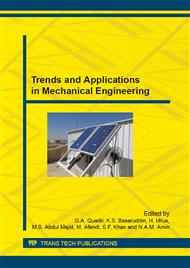p.372
p.378
p.383
p.388
p.393
p.398
p.404
p.409
p.415
An EMG Study for the Application of New Harvesting Oil Palm Fruit Device to Reduce MSDs
Abstract:
Farm workers in the Oil Palm industry in Malaysia are extremely exposed to the risk of musculoskeletal disorders (MSDs) which is directly affected to the production outputs. This paper is to discuss the way to reduce the MSDs biomechanical load by using a new design of ergonomic palm oil fruit harvesting device. According to the observation, manual harvesting process by using conventional device or device was highly risk to undergo MSDs due to repetitive awkward posture. Thus, new device is proposed for reducing the effect of MSDs. Electromyography (EMG) evaluation was conducted to determine the reliability and the efficiency of the proposed method to reduce the risk of MSDs. Results of EMG show that the using of the proposed device provides less pain compare to the conventional device.
Info:
Periodical:
Pages:
393-397
Citation:
Online since:
August 2015
Authors:
Keywords:
Price:
Сopyright:
© 2015 Trans Tech Publications Ltd. All Rights Reserved
Share:
Citation:


